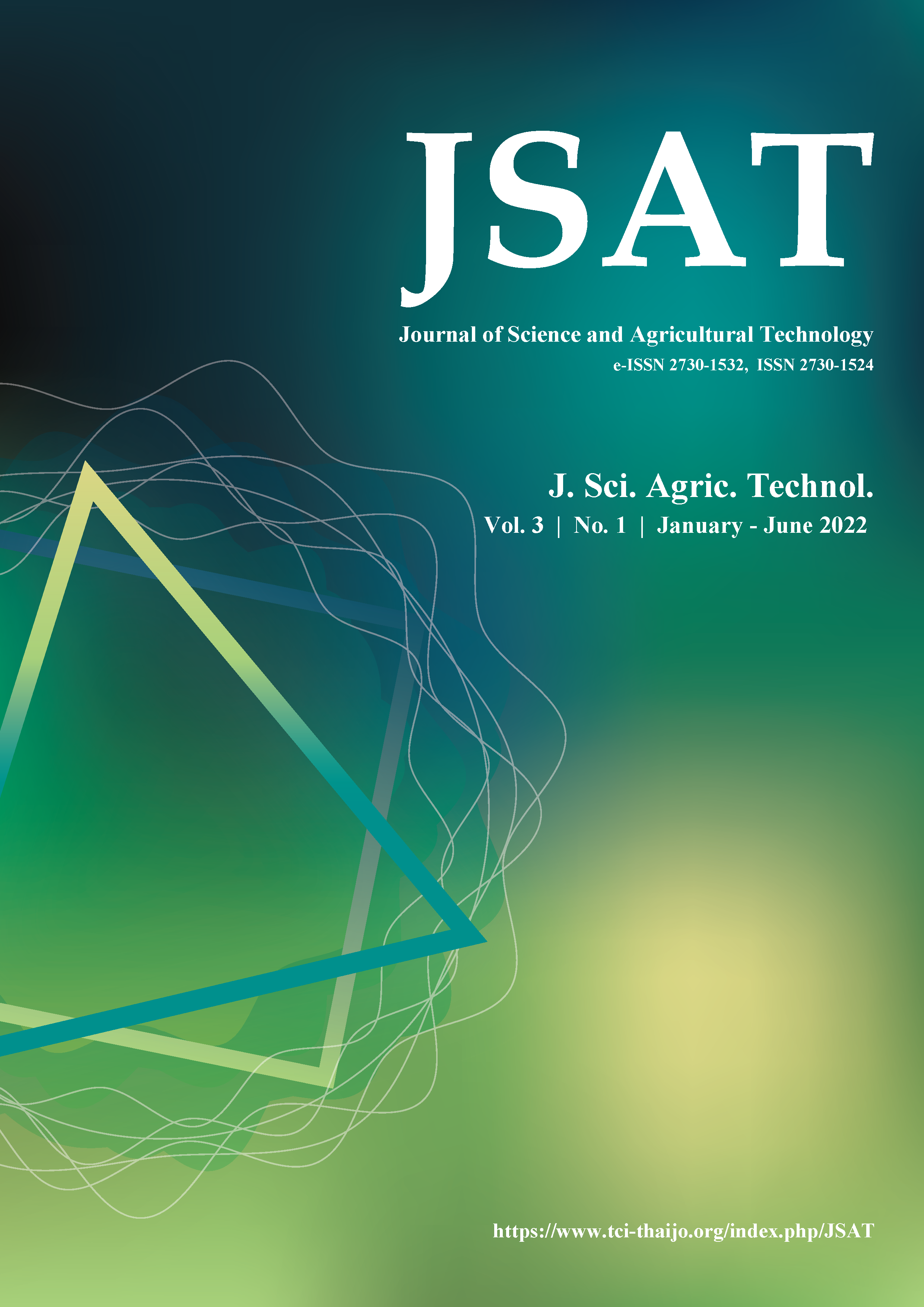Effect of N2-fixing and IAA synthesis endophytic bacteria on growth of Vanda under greenhouse condition
Main Article Content
Abstract
Vanda is one of the orchid genera that are important commercial crops. It was traded in both cut flower and plant form. In 2018, the Vanda export of Thailand had a marketable value of about 0.13% as cut flowers and 8.9% as orchid plants. Orchid cultivation is usually used a large number of fertilizers for growth and development, which lead to high cost and environmental problems. Therefore, this research was aimed to study N2- fixing and IAA produced by endophytic bacteria as biofertilizers under greenhouse conditions. This research was conducted in a completely randomized design (CRD), and Vanda plantlets from tissue culture were inoculated with isolated 3S19 endophytic bacteria compared with deionized water ( as a control treatment). Each treatment had twenty replications. The results showed that there were no significantly different between isolate 3S19 inoculation plants and with sterilized deionized water in plant height and leave number at 2, 3, and 4 months after inoculation. In contrast, root length and the number of roots were significantly different at 4 months after inoculation. The data from this research is beneficial as primary data for biofertilizer application to Vanda orchid.
Article Details

This work is licensed under a Creative Commons Attribution-NonCommercial-NoDerivatives 4.0 International License.
References
Afzal, I., Shinwari, Z.K., Sikandar, S., and Shahzad, S. 2019. Plant beneficial endophytic bacteria: Mechanisms, diversity, host range and genetic determinants. Microbiological Research. 221: 36-49. https://doi.org/10.1016/j.micres.2019.02.001.
Chiellini, C., Maida, I., Emiliani, G., Mengoni, A., Mocali, S., Fabiani, A., Biffi, S., Maggini, V., Gori, L., Vannacci, A., Gallo, E., Firenzuoli, F., and Fani, R. 2014. Endophytic and rhizospheric bacterial communities isolated from the medicinal plants Echinacea purpurea and Echinacea angustifolia. International Microbiology. 17: 165-174. https://doi.org/10.2436/20.1501.01.219.
De, L., Pathak, P., Rao, A.N., and Rajeevan, P.K. 2015. Commercial Orchids. De Gruyter Open Ltd, Berlin.
Department of Agriculture. 2017. Orchid Production Technology. Department of Agriculture, Ministry of Agriculture and Cooperatives, Bangkok.
Department of International Trade Promotion. 2020. Orchid Products. Department of International Trade Promotion, Ministry of Commerce, Thailand.
Engelhard, M., Hurek, T., and Reinhold-Hurek, B. 2000. Preferential occurrence of diazotrophic endophytes, Azoarcus spp., in wild rice species and land races of Oryza sativa in comparison with modern races. Environmental Microbiology. 2(2): 131-141. https://doi.org/10.1046/j.1462-2920.2000.00078.x
Gordon, S. A., and Weber, R. P. 1951. The colorimetric estimation of indole acetic acid. Plant Physiology. 26: 192-195. https://doi.org/10.1104/pp.26.1.192.
Hinsley, A., Boer, H.J.DE., Fay, M.F., Gale, S.W., Gardiner, L.M., Gunasekara, R.S., Kumar, P., Masters, S., Metusala, D., Roberts, D. L., Veldman, S., Wong, S., and Phelps, J. 2018. A review of the trade in orchids and its implications for conservation. Botanical Journal of the Linnean Society. 186: 435-455. https://doi.org/10.1093/botlinnean/box083.
Inkaewpuangkham, W., Panjama, K., Inkham, C., Chromkaew, Y., and Ruamrungsri, S. 2021a. Isolation and Selection Potential N-Fixing of Endophytic Bacteria in Vanda Orchid. In: Sum-im, T. (ed) The 14th Research Administration Network Conference 2021 (online). Bangkok, 5-6 Aug 2021. Strategic Wisdom and Research Institute, Srinakharinwirot University. p.87-95.
Inkaewpuangkham, W., Panjama, K., Inkham, C., Chromkaew, Y., and Ruamrungsri, S. 2021b. Assessment of IAA synthesis by endophytic bacteria in Vanda (Orchidaceae) (Book of Abstracts). In: Thammasiri, K., Kongsawadworakul, P., and Swangpol, S.C. (eds) The IX International Scientific and Practical Conference on Biotechnology as an Instrument for Plant Biodiversity Conservation (Physiological, Biochemical, Embryological, Genetic and Legal Aspects) (Biotech 2021). Faculty of Science, Mahidol University, Bangkok, Thailand, 12-13 Jul 2021. Department of Plant Science, Faculty of Science, Mahidol University. p.31.
Khalid, A., Arshad, M., and Zahir, Z.A. 2004. Screening plant growth promoting rhizobacteria for improving growth and yield of wheat. Journal of applied microbiology. 96: 473-480. https://doi.org/10.1046/j.1365-2672.2003.02161.x.
Lacava, P.T., and Azevedo, J.L. 2013. Chapter 1 Endophytic Bacteria: A Biotechnological Potential in Agrobiology System. In: Maheshwari, D.K., Saraf, M., and Aeron, A. (ed) Bacteria in Agrobiology: Crop Productivity. Springer, New York. p.1-44.
Lertjantarangkool, T., Pengnoo, A., Punsak, W., and Homhaul, W. 2017. Effectiveness of free living nitrogen fixing bacteria on seed germination of rice. In: Wattanachaiyingcharoen, D., et al. (eds) Naresurn research conference 13. Phitsanulok, 20-21 July 2017. Naresurn University. P.359-367.
Nogueira, E.M., Vinagre, F., Masuda, H.P., Vargas, C., Muniz de Pádua, V.L., Da Silva, F.R., Dos Santos, R.V., Baldani, J.I., Ferreira, P.C.G., and Hemerly, A.S. 2001. Expression of sugarcane genes induced by inoculation with Gluconacetobacter diazotrophicus and Herbaspirillum rubrisubalbicans. Genetics and Molecular Biology. 24: 199-206. https://doi.org/10.1590/S1415-47572001000100027.
Novak, S.D., Luna, L.J., and Gamage, R.N. 2014. Role of Auxin in Orchid Development. Plant Signaling & Behavior. 9(10): e972277-1- e972277-8. https://doi.org/10.4161/psb.32169.
Ou, T., Xu, W., Wang, F., Strobel, G., Zhou, Z., Xiang, Z., Liu, J., and Xie, J. 2019. A microbiome study reveals seasonal variation in endophytic bacteria among different Mulberry cultivars. Computational and Structural Biotechnology Journal. 17: 1091–1100. https://doi.org/10.1016/j.csbj.2019.07.018.
Panjama, K. 2018. Nitrogen uptake and assimilation in Vanda hybrid. Ph.D. Dissertation. Graduate school Chiang Mai University, Chiang Mai, Thailand. Ray, S., Singh, J., Rajput, R.S., Singh, H.B., and Singh, S. 2018. Endophytic Bacteria: an Essential Requirement of Phyto Nutrition. Nutrition and Food Science International Journal. (5)2: 1-5. https://doi: 10.19080/NFSIJ.2018.05.555657.
Santos, M.L.dos., Berlitz, D.L., Wiest, S.L.F., Schünemann, R., Knaak, N., and Fiuza, L.M. 2018. Benefits Associated with the Interaction of Endophytic Bacteria and Plants. Brazilian Archives of Biology and Technology. 61: e18160431, 1-10. https://doi.org/10.1590/1678-4324-2018160431.
Tsavkelova, E.A., Cherdyntseva, T.A., Botina, S.G., and Netrusov, A.I. 2007. Bacteria associated with orchid roots and microbial production of auxin. Microbiological Research. 162: 69-76. https://doi.org/10.1016/j.micres.2006.07.014.
Weaver, R. W., and Danso, Seth K. A. 1994. Dinitrogen fixation. In: Weaver, R.W., Angle, J.S., and Bottomley, P.S. (eds.). Methods of Soil Analysis. Part 2: Microbiological and Biochemical Properties. Soil Science Society of America, Inc., Madison. p. 1019-1043.
Wu, W., Chen, W., Liu, Shiyu., Wu, Jianjun., Zhu, Yeting., Qin, Luping., and Zhu, Bo. 2021. Beneficial Relationships Between Endophytic Bacteria and Medical Plants. Frontiers in Plant Science. 12: 1-13. https://doi.org/10.3389/fpls.2021.646146.
Yang, R., Liu, P., and Ye, W. 2017. Illumina-based analysis of endophytic bacterial diversity of tree peony (Paeonia Sect. Moutan) roots and leaves. Brazilian Journal of Microbiology. 48: 695-705. https://doi.org/10.1016/j.bjm.2017.02.009.


